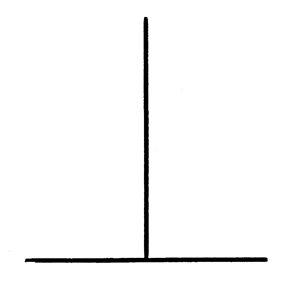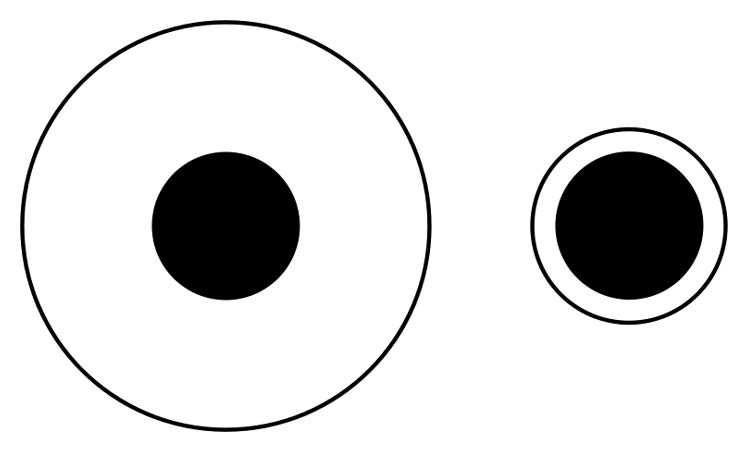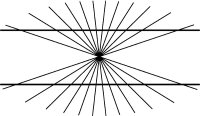ILLUSION
Muller Lyer illusion
The Müller-Lyer illusion is an optical illusion consisting of a stylized arrow. When viewers are asked to place a mark on the figure at the midpoint, they invariably place it more towards the "tail" end.
It was devised by F.C. Muller- Lyer in 1889.
Ponzo Illusion
The Ponzo illusion is a geometrical- optical illusion that was first demonstrated by the Italian psychologist Mario Ponzo (1882–1960) in 1911.
He suggested that the human mind judges an object's size based on its background. He showed this by drawing two identical lines across a pair of converging lines, similar to railway tracks. The upper line looks longer because we interpret the converging sides according to linear perspective as parallel lines receding into the distance. In this context, we interpret the upper line as though it were farther away, so we see it as longer – a farther object would have to be longer than a nearer one for both to produce retinal images of the same size.
Horizontal Vertical illusion
The vertical–horizontal illusion is the tendency for observers to overestimate the length of a vertical line relative to a horizontal line of the same length. This involves a bisecting component that causes the bisecting line to appear longer than the line that is bisected. People often overestimate or underestimate the length of the bisecting line relative to the bisected line of the same length. This even happens if people are aware that the lines are of the same length.
Jastrow illusion
Delboeuf illusion
The Delboeuf illusion is an optical illusion of relative size perception. In the best-known version of the illusion, two circles of identical size have been placed near to each other and one is surrounded by an annulus; the surrounded circle then appears larger than the non-surrounded circle if the annulus is close, while appearing smaller than the non-surrounded circle if the annulus is distant. Recent work suggests it is caused by the same visual processes that cause the Ebbinghaus illusion.
Ehrenstein illusion
The Ehrenstein illusion is an optical illusion studied by the German psychologist Walter Ehrenstein in which the sides of a square placed inside a pattern of concentric circles take an apparent curved shape
Zollner illusion
The Zöllner illusion is a classic optical illusion named after its discoverer, German astrophysicist Johann Karl Friedrich Zollner.
In this figure the black lines seem to be unparallel, but in reality they are parallel. The shorter lines are on an angle to the longer lines. This angle helps to create the impression that one end of the longer lines is nearer to the viewer than the other end. This is very similar to the way the Wundt illusion appears. It may be that the Zöllner illusion is caused by this impression of depth.
Wundt illusion
The Wundt illusion is an optical illusion that was first described by the German psychologist Wilhelm Wundt in the 19th century. The two red vertical lines are both straight, but they may look as if they are bowed inwards to some observers. The distortion is induced by the crooked lines on the background. The Hering illusion produces a similar, but inverted effect.
The Fraser spiral illusion is an optical illusion that was first described by the British psychologist James Fraser in 1908.
The illusion is also known as the false spiral, or by its original name, the twisted cord illusion. The overlapping black arc segments appear to form a spiral; however, the arcs are a series of concentric circles.
The visual distortion is produced by combining a regular line pattern (the circles) with misaligned parts (the differently colored strands). A sequence of tilted elements causes the eye to perceive phantom twists and deviations.
Sander Parallelogram illusion
The Sander illusion or Sander's parallelogram is an optical illusion described by the German psychologist Friedrich Sander (1889-1971) in 1926.
The diagonal line bisecting the larger, left-hand parallelogram appears to be considerably longer than the diagonal line bisecting the smaller, right-hand parallelogram, but is in fact the same length. One possible reason for this illusion is that the diagonal lines around the blue lines give a perception of depth, and when the blue lines are included in that depth, they are perceived as different lengths.
Poggendorff illusion
The Poggendorff Illusion is a geometrical- optical illusion that involves the misperception of the position of one segment of a transverse line that has been interrupted by the contour of an intervening structure (here a rectangle). It is named after Poggendroff, the editor of the journal, who discovered it in the figures Johann Karl Friedrich Zollner submitted when first reporting on what is now known as the Zollner illusion, in 1860.













Comments
Post a Comment